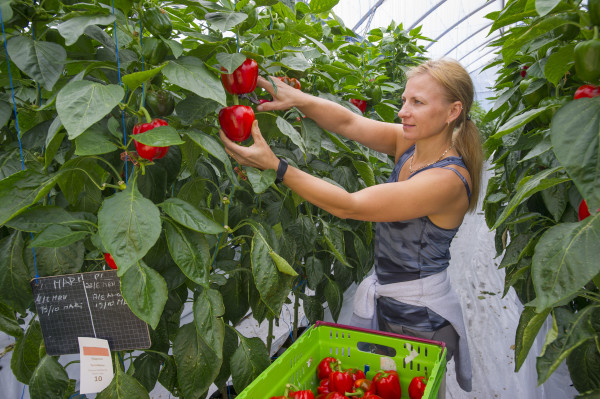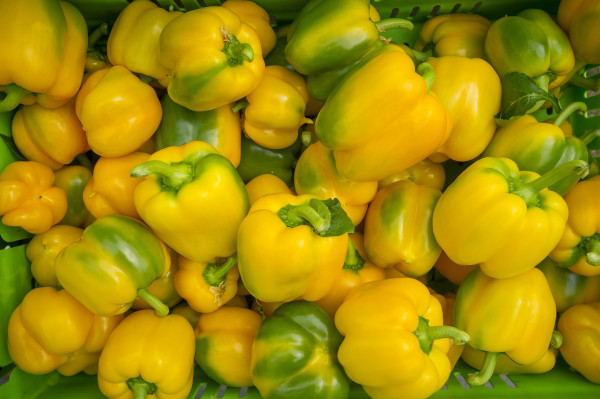Rising costs prompt search for efficiencies: Southern Belle Orchard
8 February 2023
Creating efficiencies is the strategy ahead for feijoa, capsicum and chilli grower Southern Belle. GEOFF LEWIS reports.

Maryna Nekhaieva has worked for Southern Belle for six years
Located on easy country 10 minutes from Matamata in the central Waikato, the orchard was bought by Frans and Tineke de Jong nearly 20 years ago.
Frans grew up on a dairy farm and studied chemistry and successfully established his own laboratory. Tineke had a background in floristry and she is also a keen gardener.
More recently the day-to-day running of the orchard has been taken over by their son Talbert and his partner Emily – along with their growing family.
Talbert and Emily came from a busy life in Auckland. Talbert has a dairy farming background and has wide practical experience – including running a home maintenance franchise and maintenance for Auckland’s city theatres. Emily studied marketing at Waikato University and spent 10 years in the not-for-profit sector.
Southern Belle has three hectares planted in feijoas. Also equipped with a 3000 square metre double-skinned greenhouse, they produce about 90 tonnes of capsicum of six varieties in red, yellow and orange including the long sweet pointed pepper’. They also grow several tonnes a year of the 'Kiwi hot' cayenne chilli.
The greenhouse works around a desired temperature of about 22 degrees Celsius and November to December is the peak of the season. Most product goes to market through either MG Marketing or the Farmers’ Markets at Hamilton and Tauranga.
Talbert says production overall is down this year due to the gloomy weather. By chance the feijoas missed the damaging hard frost in early October as the plants weren't yet in flower. While prices have held up, insect pests have increased.
"It's been milder. We used to get more frosts which killed off the moths and caterpillars. We use biological control, parasitic wasps and mites, with electric bug traps and some organic sprays," Talbert says.
Sparrows have also become a pest in the greenhouse and a variety of remedies have been employed including sound and smells, but strategically placed bird netting, installed about 18 months ago, seems to do the trick.
Keeping humidity under control in the greenhouse is also important in controlling insect pests. To help with this the greenhouse is vented and equipped with dehumidifiers.
"Normally you vent humidity out which means you can keep the vents closed and that creates an efficiency with heating," Talbert says.
Labour hasn't been so much of a problem at Southern Belle as it has in other areas. The orchard has a regular team of four locals, with another six coming in during picking season. But costs continue to rise on all fronts, including labour, and fertiliser which has tripled in two years.

Capsicums ready for grading in the packhouse
"We are getting higher returns but that doesn't cover the extra costs. We look at any efficiencies we can make including in fertiliser. Our heating (in the greenhouse) is waste oil which has also more than doubled in cost."
In the greenhouse capsicums and chillies are propagated hydroponically in a substrate of pumice and compost.
"We make our own compost from the capsicum prunings and local horse poo which we cook up in a pile. We've been using pots for the past seven or eight years and we like to keep a soil-like environment."
The growing capsicum plants are sustained by a recipe of seaweed and fulvic acid fertiliser mixed and pumped through from a central point.
"We try to grow year-round, which improves the efficiency of the crop turnover. We've got the time spent in pulling out old plants and replanting to about ten days, so we're back in production very quickly.
"Price can be a bit of a lottery, it can be very good but it can drop a lot as there is a lot of labour and time in picking, grading and hand-bagging chillies."
Outdoors, Southern Belle train their feijoas along wires in the espalier fashion, and there is currently a project going on to concentrate production by reducing the gaps between the rows, which were set at a generous 3m many years ago – creating another efficiency.
NZ Feijoa Growers Association manager, Ian Turk, says the 2022 year has provided varied results depending on where growers are geographically located. The industry produces about 1200 tonnes annually, with the larger growers in Gisborne, Waikato and Bay of Plenty. Northland has lost a lot of growers due to guava moth and anthracnose, a fungal infection. Almost all feijoa production goes to the domestic market as the short shelf-life of the fruit makes export difficult.
Feijoa growers have been hit by the same increases in costs – for fertilisers, fuel, and to this could be added compliance, including NZGAP (Good Agricultural Practice) which has created a disproportionate burden on small growers. As most feijoa growers are small operations, labour has not been a big issue as it has been in other sectors, he says.
Originally published in the February 2023 issue of NZGrower magazine
